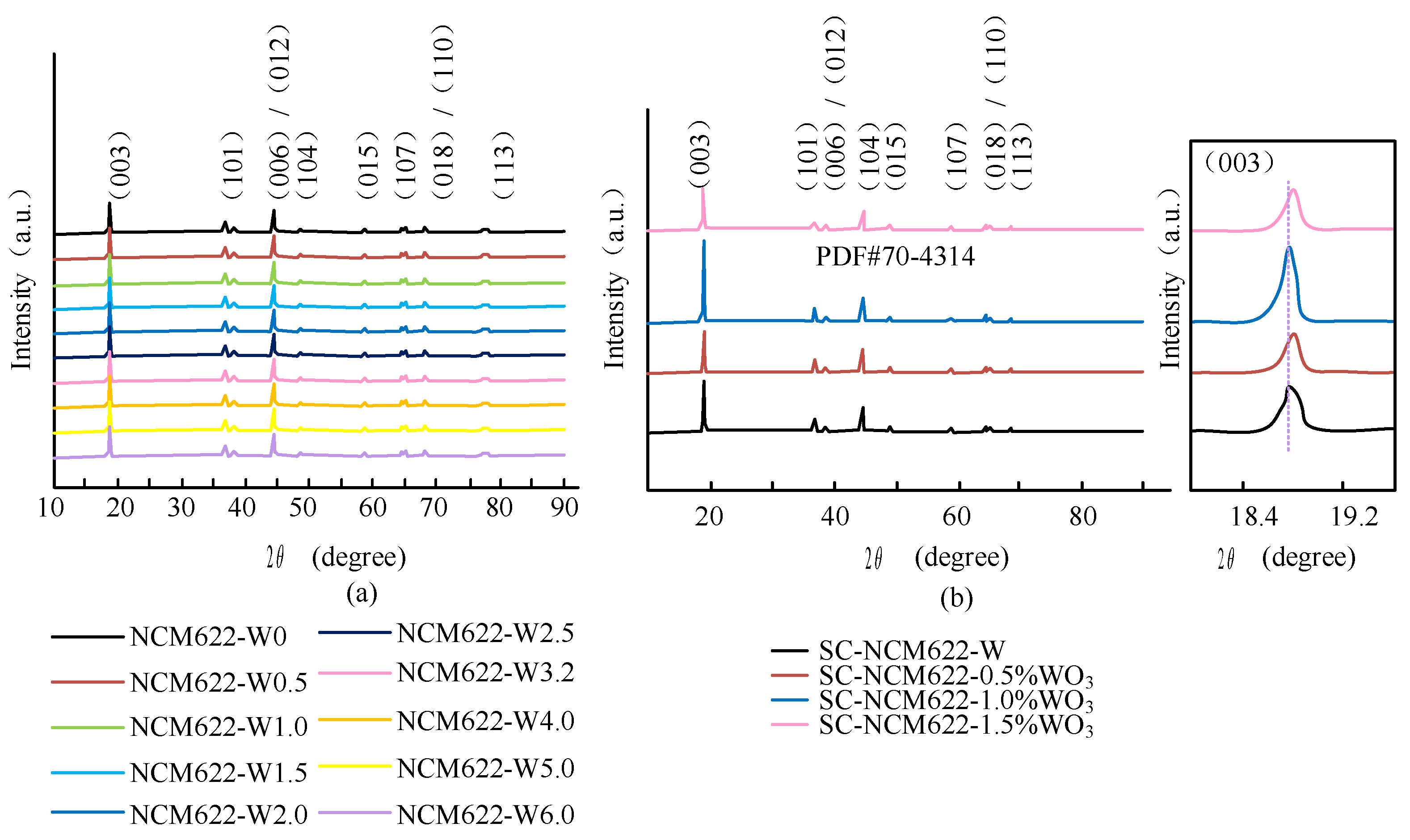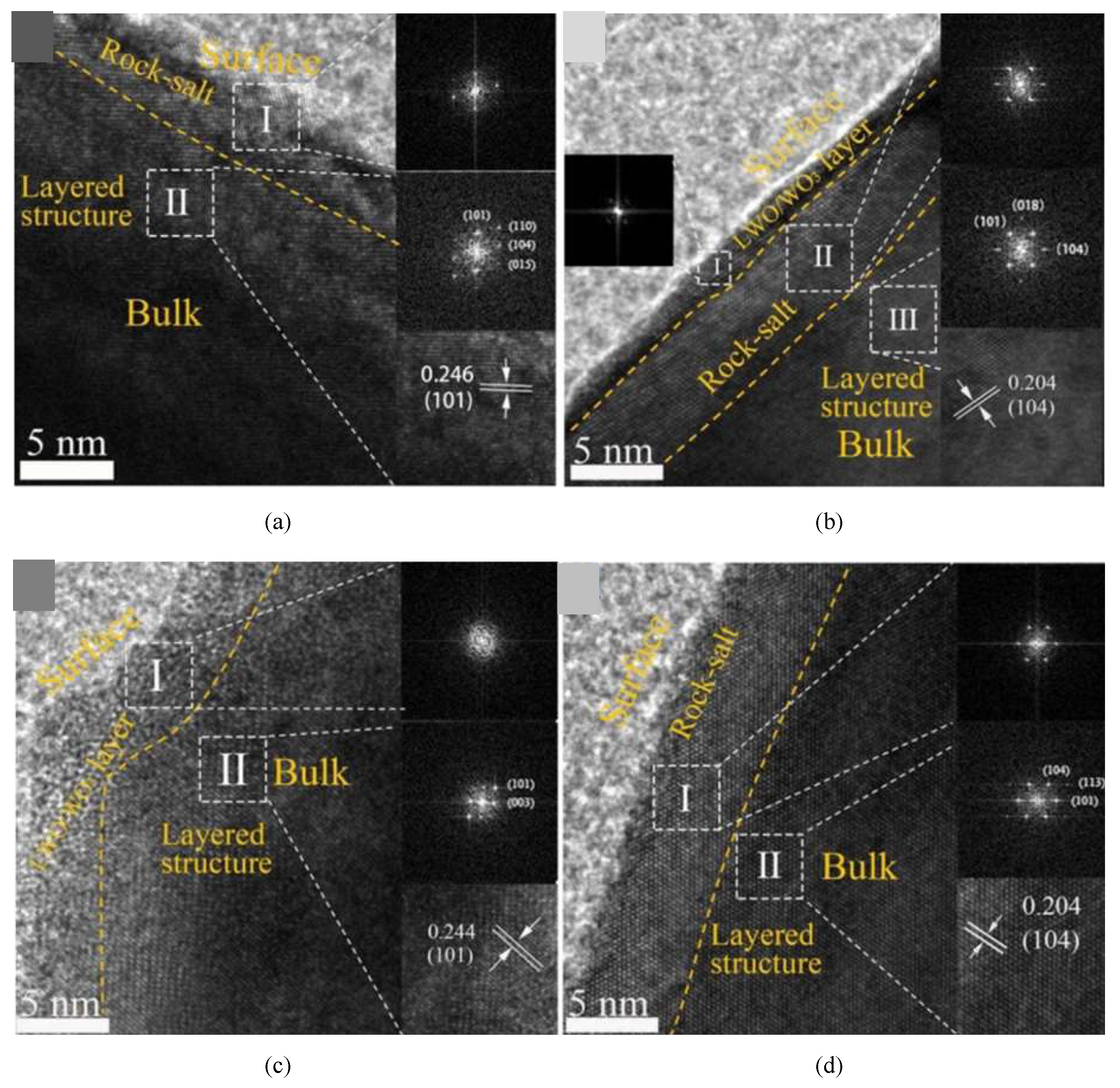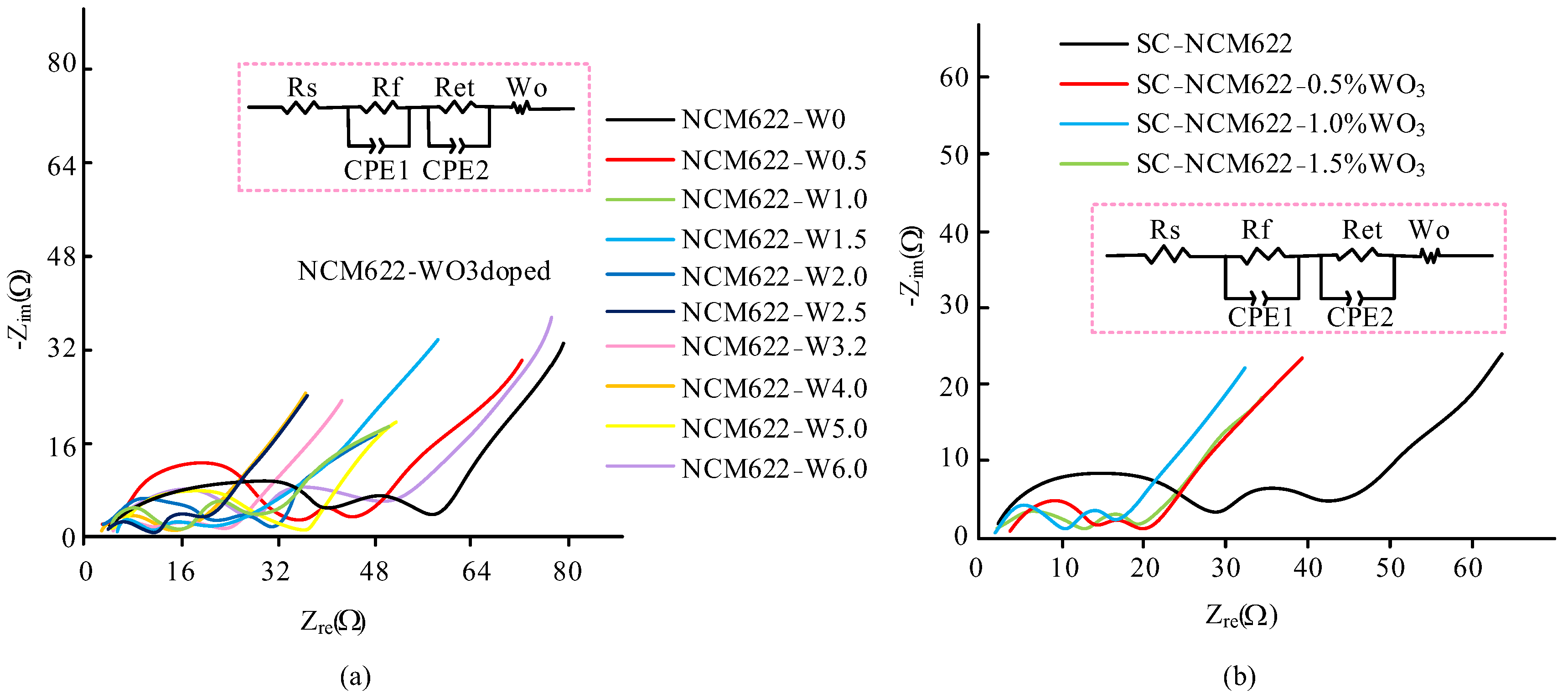The Modification of WO3 for Lithium Batteries with Nickel-Rich Ternary Cathode Materials
Abstract
:1. Introduction
2. The Modification of WO3 for Lithium Batteries with NRTCMs
2.1. Experimental Materials, Instruments, and Characterization Testing
2.1.1. Experimental Materials
2.1.2. Experimental Instruments and Equipment
2.1.3. Material Characterization Testing
2.2. Basic Preparation of NRTCMs
2.3. The Modification of Polycrystalline NRTCMs by WO3
2.4. The Modification of Single-Crystal NRTCMs by WO3
3. Result Analysis
3.1. Morphology and Structural Analysis
3.2. Analysis of CRP and XPS
3.3. Cyclic Voltammetry Analysis
3.4. Alternating Current (AC) Impedance Analysis
4. Conclusions
Author Contributions
Funding
Data Availability Statement
Conflicts of Interest
References
- Fu, F.; Liu, X.; Fu, X.; Chen, H.; Huang, L.; Fan, J.; Le, J.; Wang, Q.; Yang, W.; Ren, Y.; et al. Entropy and crystal-facet modulation of P2-type layered cathodes for long-lasting sodium-based batteries. Nat. Commun. 2022, 13, 2826. [Google Scholar] [CrossRef] [PubMed]
- Vasko, F.J.; Lu, Y.; McNally, B. A Simple Methodology that Efficiently Generates All Optimal Spanning Trees for the Ca-ble-Trench Problem. J. Comput. Cogn. Eng. 2022, 1, 13–20. [Google Scholar]
- Sarkar, A.; Biswas, A.; Kundu, M. Development of q-Rung Orthopair Trapezoidal Fuzzy Einstein Aggregation Operators and Their Application in MCGDM Problems. J. Comput. Cogn. Eng. 2022, 1, 109–121. [Google Scholar]
- Mu, K.; Cao, Y.; Hu, G.; Du, K.; Yang, H.; Gan, Z.; Peng, Z. Enhanced electrochemical per-formance of Li-rich cathode Li1.2Ni0.2Mn0.6O2 by surface modification with WO3 for lithium ion batteries. Electrochim. Acta 2018, 273, 88–97. [Google Scholar] [CrossRef]
- Gholami, P.; Khataee, A.; Bhatnagar, A.; Vahid, B. Synthesis of N-doped magnetic WO3–x@ Mesoporous carbon using a diatom template and plasma modification: Visible-light-Driven Photocatalytic activities. ACS Appl. Mater. Interfaces 2021, 13, 13072–13086. [Google Scholar] [CrossRef]
- Das, K.K.; Sahoo, D.; Mansingh, S.; Parida, K. ZnFe2O4@WO3-X/Polypyrrole: An Efficient Ternary Photocatalytic System for Energy and Environmental Application. ACS Omega 2021, 6, 30401–30418. [Google Scholar]
- Wang, B.; Zhang, F.-L.; Zhou, X.-A.; Wang, P.; Wang, J.; Ding, H.; Dong, H.; Liang, W.-B.; Zhang, N.-S.; Li, S.-Y. Which of the nickel-rich NCM and NCA is structurally superior as a cathode material for lithium-ion batteries? J. Mater. Chem. A 2021, 9, 13540–13551. [Google Scholar] [CrossRef]
- Xiao, Z.; Liu, P.; Song, L.; Cao, Z.; Du, J.; Zhou, C. The correlation between structure and thermal properties of nickel-rich ternary cathode materials: A review. Ionics 2021, 27, 3207–3217. [Google Scholar] [CrossRef]
- Lee, G.; Jung, K.; Lee, Y.; Kim, J.; Yim, T. Interface-Stabilized Layered Lithium Ni-Rich Oxide Cathode via Surface Functionali-zation with Titanium Silicate. ACS Appl. Mater. Interfaces 2021, 13, 47696–47705. [Google Scholar] [CrossRef]
- Mao, G.; Luo, J.; Zhou, Q.; Xiao, F.; Tang, R.; Li, J. Improved cycling stability of high nickel cathode material for lithium ion battery through Al- and Ti-based dual modification. Nanoscale 2021, 44, 18741–18753. [Google Scholar] [CrossRef] [PubMed]
- Xia, D.; Hu, S.; Ding, N.; Wen, M.; Xiao, Q.; Zhong, S. Submicron single-crystal structure for enhanced structural stability of LiNi0.8Mn0.2O2 Ni-rich cobalt-free cathode materials. Ionics 2023, 29, 1699–1709. [Google Scholar] [CrossRef]
- Geng, Z.; Shi, W.; Wang, J.; Zhang, X.; Hu, N.; Wang, S. A high-voltage solid-state organic lithium battery based on 2,3,5,6-tetrafluoro-7,7,8,8-tetracyanoquinodimethane cathode. Int. J. Energy Res. 2022, 9, 12316–12322. [Google Scholar] [CrossRef]
- Kaneda, H.; Furuichi, Y.; Ikezawa, A.; Arai, H. Effects of aluminum substitution in nickel-rich layered LiNixAl1xO2 (x = 0.92, 0.95) positive electrode materials for Li-ion batteries on high-rate cycle performance. J. Mater. Chem. A 2021, 38, 21981–21994. [Google Scholar] [CrossRef]
- Xiao, C.; Xia, M.; Ye, W.; Zhang, X.; Chen, S.; Yu, H.; Bi, W.; Shui, M.; Shu, J. The positive effect of nitridation on CrNb49O124 nanowires for high-performance lithium-ion storage. Ceram. Int. 2020, 46, 15527–15533. [Google Scholar] [CrossRef]
- Fang, W.; Lin, Y.; Xv, R.; Fu, L. Boosting Photoelectrochemical Performance of BiVO4 Photoanode by Synergistic Effect of WO3/BiVO4 Heterojunction Construction and NiOOH Water Oxidation Cocatalyst Modification. ACS Appl. Energy Mater. 2022, 5, 11402–11412. [Google Scholar] [CrossRef]
- Li, X.; Ai, M.; Zhang, X.; Zou, J.J.; Pan, L. Dual co-catalysts decorated Zn-WO3 nanorod arrays with highly efficient photoelec-trocatalytic performance. Int. J. Hydrogen Energy 2022, 47, 13641–13653. [Google Scholar] [CrossRef]
- Ou, L.; Nong, S.; Yang, R.; Li, Y.; Tao, J.; Zhang, P.; Zhou, W. Multi-Role Surface Modification of Single-Crystalline Nickel-Rich Lithium Nickel Cobalt Manganese Oxides Cathodes with WO3 to Improve Performance for Lithium-Ion Batteries. Nanomaterials 2022, 12, 1324. [Google Scholar] [CrossRef] [PubMed]
- Yin, X.; Qiu, W.; Li, W.; Wang, K.; Yang, X.; Du, L.; Li, J. Effects of alkali ion on boosting WO3 photoelectrochemical performance by electrochemical doping. Int. J. Hydrogen Energy 2020, 45, 19257–19266. [Google Scholar] [CrossRef]
- Bekarevich, R.; Pihosh, Y.; Tanaka, Y.; Nishikawa, K.; Matsushita, Y.; Hiroto, T.; Takada, K. Conversion reaction in the bind-er-free anode for fast-charging Li-ion batteries based on WO3 nanorods. ACS Appl. Energy Mater. 2020, 3, 6700–6708. [Google Scholar] [CrossRef]
- Khan, K.; Fu, B.; Xin, H.; Beshiwork, B.A.; Hanif, M.B.; Wu, J.; Wu, M. Composite polymer electrolyte incorporating WO3 nanofillers with enhanced performance for dendrite-free solid-state lithium battery. Ceram. Int. 2023, 49, 4473–4481. [Google Scholar] [CrossRef]
- Sun, J.; Li, L.; Ge, S.; Zhao, P.; Zhu, P.; Wang, M.; Yu, J. Dual-mode aptasensor assembled by a WO3/Fe2O3 heterojunction for paper-based colorimetric prediction/photoelectrochemical multicomponent analysis. ACS Appl. Mater. Interfaces 2021, 13, 3645–3652. [Google Scholar] [CrossRef]
- Hu, C.; Li, L.; Zhou, J.; Li, B.; Zhao, S.; Zou, C. Enhanced Contrast of WO3-Based Smart Windows by Continuous Li-Ion Insertion and Metal Electroplating. ACS Appl. Mater. Interfaces 2022, 14, 32253–32260. [Google Scholar] [CrossRef]
- Tan, X.; Yu, H.; Liang, B.; Han, M.; Ge, S.; Zhang, L.; Yu, J. A target-driven self-feedback paper-based photoelectrochemical sensing platform for ultrasensitive detection of ochratoxin A with an In2S3/WO3 heterojunction structure. Anal. Chem. 2022, 94, 1705–1712. [Google Scholar] [CrossRef]
- Li, Y.; Zhang, W.; Qiu, B. Enhanced surface charge separation induced by Ag nanoparticles on WO3 photoanode for photoelectrochemical water splitting. Chem. Lett. 2020, 49, 741–744. [Google Scholar] [CrossRef]
- Long, X.M.; Chen, Y.J.; Zhou, J. Development of AR Experiment on Electric-Thermal Effect by Open Framework with Simulation-Based Asset and User-Defined Input. In Artificial Intelligence and Applications; Bon View Publishing: Singapore, 2023; Volume 1, pp. 52–57. [Google Scholar]
- Dang, X.; Jiang, X.; Zhang, T.; Zhao, H. WO3 inversce opal photonic crystals: Unique property, synthetic methods and extensive application. Chin. J. Chem. 2021, 39, 1706–1715. [Google Scholar] [CrossRef]
- Li, T.; Guo, X.; Zhang, L.; Yan, T.; Jin, Z. 2D CoP supported 0D WO3 constructed S-scheme for efficient photocatalytic hydro-gen evolution. Int. J. Hydrogen Energy 2021, 46, 20560–20572. [Google Scholar] [CrossRef]
- Wang, J.; Shao, Y.; Yuan, F.; Sun, H.; Zhang, D.; Li, Z.; Wang, B. Hierarchically designed MoWSe2/WO3/C anode for fast and efficient Na+ storage. J. Energy Chem. 2023, 80, 291–301. [Google Scholar] [CrossRef]
- Islam, A.; Othman, F.; Sakib, N.; Babu, H.M.H. Prevention of Shoulder-Surfing Attack Using Shifting Condition with the Digraph Substitu-tion Rules. In Artificial Intelligence and Applications; Bon View Publishing: Singapore, 2023; Volume 1, pp. 58–68. [Google Scholar]
- Lou, F.; Xie, Q.; Luo, X.; Xie, Y.; Wang, M.; Hao, H.; Wang, Z.; Yang, L.; Wang, G.; Chen, J.; et al. Ind. Eng. Chem. Res. 2022, 61, 4588–4600. [CrossRef]
- Shenouda, S.S.; Al Abdulaal, T.H.; Zahran, H.Y.; Yahia, I.S. Synthesis, structure identification and linear/nonlinear optics of hy-drothermally grown WO3 nanostructured thin film/FTO: Novel approach. Ceram. Int. 2022, 48, 7663–7667. [Google Scholar] [CrossRef]
- Samuel, O.; Othman MH, D.; Kamaludin, R.; Sinsamphanh, O.; Abdullah, H.; Puteh, M.H.; Kurniawan, T.A. WO3–based photo-catalysts: A review on synthesis, performance enhancement and photocatalytic memory for environmental applications. Ceram. Int. 2022, 48, 5845–5875. [Google Scholar] [CrossRef]
- Bingah, O.K.; Pritzker, M.D. Graphite felt modified with WO3, SnO2, and binary WO3/SnO2-mixtures as novel positive elec-trodes for cerium-based redox flow batteries. Int. J. Energy Res. 2022, 46, 4680–4698. [Google Scholar] [CrossRef]
- Badiezadeh, F.; Kimiagar, S. Modified WO3 nanosheets by N-GO nanocomposites to form NO2 sensor. J. Exp. Nanosci. 2021, 16, 144–158. [Google Scholar] [CrossRef]
- Sun, Y.; Ren, D.; Liu, G.; Mu, D.; Wang, L.; Wu, B. Correlation between thermal stabilities of nickel-rich cathode materials and battery thermal runaway. Int. J. Energy Res. 2021, 45, 20867–20877. [Google Scholar] [CrossRef]
- Li, W.; Zhang, J.; Zhou, Y.; Huang, W.; Liu, X.; Li, Z.; Gao, M.; Chang, Z.; Li, N.; Wang, J.; et al. Regulating the Grain Orientation and Surface Structure of Primary Particles through Tungsten Modification to Comprehensively Enhance the Performance of Nickel-Rich Cathode Materials. ACS Appl. Mater. Interfaces 2020, 12, 47513–47525. [Google Scholar] [CrossRef] [PubMed]
- Chen, Z.; Gao, X.; Kim, J.; Kim, G.; Passerini, S. Quasi-Solid-State Lithium Metal Batteries Using the LiNi0.8Co0.1Mn0.1O2-Li1+xAlxTi2-x(PO4)3 Composite Positive Electrode. ACS Appl. Mater. Interfaces 2021, 13, 53810–53817. [Google Scholar] [CrossRef] [PubMed]
- Takeuchi, T.; Kageyama, H.; Nakanishi, K.; Kiuchi, H.; Katayama, M.; Inada, Y. Improvement of Cycle Capability of Fe-Substituted Li2S-Based Positive Electrode Materials by Doping with Lithium Iodide. J. Electrochem. Soc. 2019, 166, 5231–5236. [Google Scholar] [CrossRef] [Green Version]











| Reagent Name | Chemical Formula | Specifications | Manufacturer |
|---|---|---|---|
| Lithium Hydroxide MonoHydrate | LiOH·H2O | ≥98% | Hangzhou, China, Aladdin Company |
| Lithium carbonate | Li2CO3 | >98% | Hangzhou, China, Aladdin Company |
| Nickel sulfate hexahydrate | NiSO4·6H2O | ≥99% | Hangzhou, China, Aladdin Company |
| Cobalt sulfate heptahydrate | CoSO4·7H2O | ≥99% | Hangzhou, China, Aladdin Company |
| Manganese sulfate monohydrate | MnSO4·H2O | ≥99% | Hangzhou, China, Aladdin Company |
| Acetylene black | C | Battery level | Shenzhen, China, Xilong Chemical Co., Ltd. |
| N-methylpyrrolidone | C5H9NO | Battery level | Hangzhou, China, Aladdin Company |
| ammonia | NH4OH | 25–28% | Hangzhou, China, Aladdin Company |
| Tungsten trioxide | WO3 | ≥99% | Hangzhou, China, Aladdin Company |
| Vinylidene fluoride | <(CH2-CF2)n- | Battery level | Shenzhen, China, Xilong Chemical Co., Ltd. |
| electrolyte | LiPF6(EC:EMC:DMC) | Battery level | Suzhou, China, Duoduo Chemical Reagent Network |
| Lithium flake | Li | Battery level | Suzhou, China, Duoduo Chemical Reagent Network |
| the diaphragm | PP/PE/PP | Battery level | Shenzhen, China, Shenzhen Kejing Co., Ltd. |
| Battery case | -- | Battery level | Taiyuan, China, Shanxi Lizhiyuan Battery Materials Co., Ltd. |
| Experimental Instruments | Model | Manufacturer |
|---|---|---|
| Electronic balance | AR64CN | Changzhou Aohaosi Instrument Co., Ltd., Changzhou, China |
| A magnetic stirrer | 79-2 | Leici Company, Shanghai, China |
| Ultrasonic cleaning machine | KQ3200DB | Kunshan Ultrasonic Instrument Company, Kunshan, China |
| Vacuum drying oven | DZF-6050 | Changzhou Henglong Instrument Co., Ltd., Changzhou, China |
| Glove box | Lab 2000 | Etelux Company, Beijing, China |
| Automatic coating machine | PX-TB-W1 | Pengxiang Yunda Co., Ltd., Shenzhen, China |
| Experimental roller press | PX-GY-100 | Pengxiang Yunda Co., Ltd., Shenzhen, China |
| Button cell hydraulic sealing machine | PX-YF-20 | Pengxiang Yunda Co., Ltd., Shenzhen, China |
| Atmosphere tube electric furnace | SK-G05143 | Tianjin Zhonghuan Electric Furnace Co., Ltd., Tianjin, China |
| Gamry Electrochemical Workstation | Reference 600 | Gamry Instruments, Inc, Philadelphia, PA, USA |
| Scanning electron microscope | JSM-6510 | Japan Corporation, Aichi Kariya City, Japan |
| Scanning electron microscope | Zeiss Sigma 500 | Carl Zeiss (Shanghai) Management Co., Ltd., Oberkoheng, Germany |
| Transmission electron microscope | Tecnai G2 F20 | FEI Corporation of the United States, Hillsboro, OR, United States |
| X-ray photoelectron spectrometer | Thermo ESCALAB 250XI | Thermo Fisher Scientific, Waltham, MA, USA |
| X-ray diffractometer | Mini Flex600 | Nippon Science Corporation, Shanghai, China |
| Vacuum circulating water suction filter | SHZ-D(III) | Henan Yuhua Instrument Co., Ltd., Luoyang, China |
| Samples | c/a | I (003)/I (104) | |||
|---|---|---|---|---|---|
| NCM622-W0 | 2.868 | 14.215 | 4.9564 | 101.25 | 1.31 |
| NCM622-W0.5 | 2.870 | 14.214 | 4.9526 | 101.33 | 1.27 |
| NCM622-W1.0 | 2.871 | 14.221 | 4.9533 | 101.50 | 1.35 |
| NCM622-W1.5 | 2.870 | 14.215 | 4.9530 | 101.37 | 1.08 |
| NCM622-W2.0 | 2.869 | 14.214 | 4.9543 | 101.31 | 1.17 |
| NCM622-W2.5 | 2.870 | 14.213 | 4.9523 | 101.38 | 1.52 |
| NCM622-W3.2 | 2 870 | 14. 220 | 4.9547 | 101.43 | 1.23 |
| NCM622-W4.0 | 2.872 | 14. 227 | 4.9537 | 101.65 | 1.22 |
| NCM622-W5.0 | 2.870 | 14. 222 | 4.9554 | 101.40 | 1.26 |
| NCM622-W6.0 | 2.875 | 14.232 | 4.9503 | 101.89 | 1.05 |
| SC-NCM622 | 2.868 | 14.213 | 4.9557 | 101.264 | 1.24 |
| SC-NCM622-0.5%WO3 | 2.872 | 14.224 | 4.9526 | 101.590 | 1.07 |
| SC-NCM622-1.0%WO3 | 2.868 | 14.211 | 4.9550 | 101.259 | 1.69 |
| SC-NCM622-1.5%WO3 | 2.872 | 14.221 | 4.9516 | 101.565 | 1.00 |
| Samples | Cycles | Rs (Ω) | Rf (Ω) | Rct (Ω) | Rf + Rct (Ω) | DLi+ (cm2/s) |
| NCM622-W0 | 6th | 10.15 | 13.37 | 32.1 | 45.47 | 3.92 × 10−14 |
| NCM622-W0.5 | 6th | 4.728 | 8.13 | 29.35 | 37.48 | 3.21 × 10−14 |
| NCM622-W1.0 | 6th | 3.724 | 11.17 | 11.63 | 22.80 | 4.75 × 10−14 |
| NCM622-W1.5 | 6th | 3.967 | 15.53 | 9.989 | 25.52 | 2.99 × 10−14 |
| NCM622-W20. | 6th | 2.696 | 18.58 | 9.007 | 27.59 | 4.95 × 10−14 |
| NCM622-W25 | 6th | 2.99 | 7761 | 8.378 | 16.14 | 7.64 × 10−14 |
| NCM622-W3.2 | 6th | 11.13 | 8795 | 3.943 | 12.74 | 7.59 × 10−14 |
| NCM622-W4.0. | 6th | 2.786 | 9721 | 5.635 | 15.36 | 8.02 × 10−14 |
| NCM622-W50 | 6th | 5.156 | 24.71 | 6.085 | 30.79 | 8.40 × 10−14 |
| NCM622-W6.0 | 6th | 3.837 | 22.09 | 12.92 | 35.01 | 3.38 × 10−14 |
| Samples | Cycles | Rs (Ω) | Rf (Ω) | Rct (Ω) | - | - |
| SC-NCM622 | 10th | 2.097 | 24.13 | 15.01 | - | - |
| SC-NCM622-0.5%WO3 | 10th | 3.497 | 10.23 | 6.087 | - | - |
| SC-NCM622-1.0%WO3 | 10th | 1.887 | 8.207 | 5.849 | - | - |
| SC-NCM622-1.5%WO3 | 10th | 2.102 | 10.48 | 6.359 | - | - |
Disclaimer/Publisher’s Note: The statements, opinions and data contained in all publications are solely those of the individual author(s) and contributor(s) and not of MDPI and/or the editor(s). MDPI and/or the editor(s) disclaim responsibility for any injury to people or property resulting from any ideas, methods, instructions or products referred to in the content. |
© 2023 by the authors. Licensee MDPI, Basel, Switzerland. This article is an open access article distributed under the terms and conditions of the Creative Commons Attribution (CC BY) license (https://creativecommons.org/licenses/by/4.0/).
Share and Cite
Xu, L.; Bao, C.; Zhou, H.; Li, J. The Modification of WO3 for Lithium Batteries with Nickel-Rich Ternary Cathode Materials. Processes 2023, 11, 1756. https://doi.org/10.3390/pr11061756
Xu L, Bao C, Zhou H, Li J. The Modification of WO3 for Lithium Batteries with Nickel-Rich Ternary Cathode Materials. Processes. 2023; 11(6):1756. https://doi.org/10.3390/pr11061756
Chicago/Turabian StyleXu, Lipeng, Chunjiang Bao, Haobing Zhou, and Jun Li. 2023. "The Modification of WO3 for Lithium Batteries with Nickel-Rich Ternary Cathode Materials" Processes 11, no. 6: 1756. https://doi.org/10.3390/pr11061756






